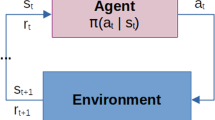Abstract
This article tries to establish synergies between two areas of research and development that are apparently disconnected: artificial intelligence (AI) and quantum computing (QC). The article begins with a brief description of the origins of AI and the type of problems that AI tries to solve. Next, we focus on a specific type of AI program, the so-called rule-based system (RBS). In this regard, one of the biggest problems with RBS is the pattern-matching that is related to the process of rule selection. This makes RBS very sensitive to the size of the problem and to changing environments, which is at the core of a very significant increase in computational cost. In this context we wonder if the use of QC techniques could help solve the problem. We have already presented ideas and concepts in the quantum world that could contribute to improving the performance of RBS. We place special emphasis on the principle of coherent superposition, on the intrinsically parallel character of QC, on the probabilistic nature of QC, and we describe some quantum operators that, of course, must be reversible. Next, we build a quantum architecture equivalent to a conventional inferential circuit and analyze the results. The article continues with the construction of a quantum rule-based system that solves a hypothetical problem in the field of medicine. Finally, the proposed approach is discussed, and preliminary conclusions are established.




Similar content being viewed by others
References
Deutsch, D.: Quantum theory, the Church-Turing principle and the universal quantum computer. Proc. R. Soc. Lond. A 400, 97–117 (1985)
Feynman, R.P.: Simulating physics with computers. Int. J. Theor. Phys. 21, 467–488 (1982)
Hayes-Roth, F., Waterman, D.A., Lenat, D.B.: Building Expert Systems. Addison-Wesley Longman Publishing Co., Inc., Boston (1983)
Moret-Bonillo, V., Alonso-Betanzos, A., Guijarro-Berdiñas, B., Cabrero-Canosa, M., Mosqueira-Rey, E.: Fundamentos de Diseño de Sistemas Inteligentes (in Spanish, in press) Delta (eds.) (2018)
Benioff, P.: Quantum mechanical hamiltonian models of turing machines. J. Stat. Phys. 29, 515–546 (1982)
Shannon, C.E., Weaver, W.: The Mathematical Theory of Communication. Univ of Illinois Press, Champaign (1949)
Heisenberg, W.: Ueber den anschaulichen Inhalt der quantentheoretischen kinematik und mechanik. Z. Phys. 172–198. 1927. English translation: The physical contents of quantum kinematics and mechanics. In: Wheeler, J.A., Zurek, W.H. (eds.) Quantum Theory and Measurement, pp. 62–84. Princeton University Press, Princeton, NJ (1983)
Toffoli, T.: Reversible computing. MIT Technical Report MIT/LCS/TM-151 (1980)
IBM QUANTUM EXPERIENCE. https://quantumexperience.ng.bluemix.net/qx/experience (2017)
Moret-Bonillo, V.: Can artificial intelligence benefit from quantum computing? Prog. Artif. Intell. 3, 89–105 (2015)
Moret-Bonillo, V.: Adventures in Computer Science: From Classical Bits to Quantum Bits. Springer, Berlin (2017)
Acknowledgements
This research was partially funded by the Xunta de Galicia (Grant Code GRC2014/035). This work has also received financial support from the Xunta de Galicia (Centro singular de investigación de Galicia accreditation 2016–2019) and the European Union (European Regional Development Fund - ERDF). Special thanks to IBM for making part of this work possible through the IBM Quantum Experience resources.
Author information
Authors and Affiliations
Corresponding author
Rights and permissions
About this article
Cite this article
Moret-Bonillo, V. Emerging technologies in artificial intelligence: quantum rule-based systems. Prog Artif Intell 7, 155–166 (2018). https://doi.org/10.1007/s13748-017-0140-6
Received:
Accepted:
Published:
Issue Date:
DOI: https://doi.org/10.1007/s13748-017-0140-6




